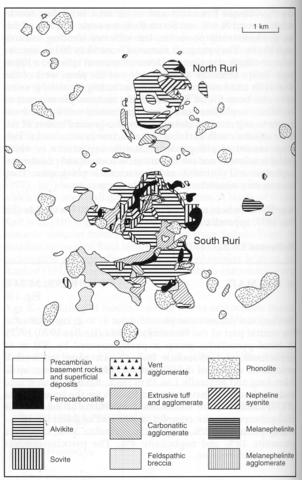stripes
Ruri is a twin complex of adjacent, contemporaneous, deeply eroded and very similar carbonatitic volcanoes, the same sequence of rock types occurring in each centre (Le Bas, 1977). Intrusive and extrusive carbonatites and carbonatite agglomerates are the predominant rocks with some nepheline syenite in both centres and numerous phonolite plugs both within the complexes and scattered over the surrounding area (see No. 085-00-040). The country rocks are Nyanzian metabasalts which have been domed by as much as 600 m, as notably demonstrated in North Ruri where much of the central area is occupied by fenitized basement rocks. Most of the volcanic superstructure has been lost to erosion but limited areas of extrusive agglomerate and tuff remain. Close to the middle of both centres are small areas of melanephelinite lavas and agglomerates, but these are considered to have originated in the Kisingiri volcano (No. 085-00-038). The earliest intrusive rocks are ijolites, but these are only found as fragments in agglomerates and breccias and xenoliths in phonolite plugs. They vary from melteigite to urtite. Nepheline syenite forms a number of small bodies in both centres, a larger 600x400 m intrusion in North Ruri and is found amongst all the pyroclastic units. It consists of poikilitic alkali feldspar, nepheline and pyroxene zoned from pale green cores to aegirine-augite or aegirine rims. Accessories and minerals in small veins include wollastonite, cancrinite, eudialyte and gotzenite. The carbonatites were emplaced principally as cone sheets the earliest being sovite which is much more extensively developed on South Ruri. It comprises calcite with accessory magnetite, biotite, aegirine and apatite. This was followed by alvikite, which is much the most extensive carbonatite in both centres, and highly variable in colour, texture and accessory mineralogy. Magnetite, biotite and apatite are the most common accessories and aegirine-augite, pyrochlore, fluorite, baryte and andradite less so. The third intrusive carbonatite phase involves cone sheets and dykes of ferrocarbonatite five varieties of which are distinguished by Le Bas (1977) including a rare earth-bearing variety with monazite and baryte. Pyroclastic rocks are extensive within the complex and include tuffs and agglomerates both intrusive and extrusive. The agglomerates contain a wide range of fragments of country rocks and all the major rocks of the complex are set in a matrix of carbonatitic tuff or carbonatite. Keller (1989) briefly describes these rocks as “densely agglutinated carbonatite agglomerate that probably resulted from vigorous lava fountaining….. this agglomerate mantles the walls of the South Ruri caldera with a thick veneer of carbonatite spatter”. There are numerous rock analyses in Le Bas (1977) and C and O isotope data in Deines and Gold (1973). Kalt et al. (1997) give Sr, Nd and Pb isotope data for four samples of carbonatite.
DEINES, P. and GOLD, D.P. 1973. The isotopic composition of carbonatite and kimberlite carbonates and their bearing on the isotopic composition of deep-seated carbon. Geochimica et Cosmochimica Acta, 37: 1709-33.KALT, A., HEGNER, E. and SATIR, M. 1997. Nd, Sr, and Pb isotopic evidence for diverse lithospheric mantle sources of East African rift carbonatites. Tectonophysics, 278: 31-45.KELLER, J. 1989. Extrusive carbonatites and their significance. In: K. Bell (ed) Carbonatites: genesis and evolution. 70-88. Unwin Hyman, London.LE BAS, M.J. 1977. Carbonatite-nephelinite volcanism: an African case history. John Wiley, London. 347 pp.

